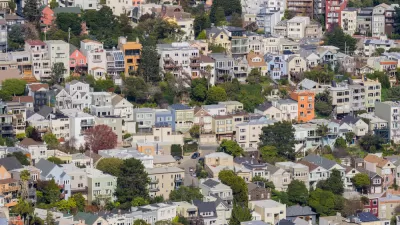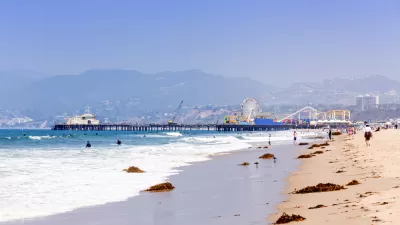Anti-housing development planning now has consequences in California.

Garth Meyer reports for Easy Reader on a notable departure from an anti-development tradition in the Southern California beach town of Redondo Beach, where a developer has proposed the development of 2,300 residential units, hotels, and offices on a 50-acre site that formerly housed an AES power plant.
The development proposal is made possible by state laws requiring local governments to make accommodations for allotted housing construction in the local housing element of the general plan through the every-eight-years process called the Regional Housing Needs Assessment (RHNA). As documented by Diana Ionescu for Planetizen in April 2022, the state's Department of Housing and Community Development (HCD) has a new mandate to enforce the requirements for local governments to complete a new housing element every eight years, enacted by a state law approved in 1969.
Redondo Beach was one of a handful of cities to run afoul of HCD regulators by under-planning for new housing—a club that includes nearby Los Angeles and Santa Monica (although Los Angeles has since rectified its position with state regulators). Nowadays, failing the RHNA test comes with the consequence of losing local control over some land use approvals. Redondo Beach is currently discovering the consequences of their inaction.
More details on the proposed development and the state laws that precipitated this historic moment in Redondo Beach and California development history can be found in an article by Steven Sharp for Urbanize LA. “Pustilnikov is also pursuing vesting rights under SB 330, which would preserve his ability to develop the property in the event that the City of Redondo Beach is able to obtain state certification of its housing element,” adds Sharp.
More on California's crackdown on housing scofflaws can be found in this August editorial published by the Los Angeles Times.
FULL STORY: Pustilnikov files for 2,320 housing units, hotel, office complex, park at AES

Planetizen Federal Action Tracker
A weekly monitor of how Trump’s orders and actions are impacting planners and planning in America.

Map: Where Senate Republicans Want to Sell Your Public Lands
For public land advocates, the Senate Republicans’ proposal to sell millions of acres of public land in the West is “the biggest fight of their careers.”

Restaurant Patios Were a Pandemic Win — Why Were They so Hard to Keep?
Social distancing requirements and changes in travel patterns prompted cities to pilot new uses for street and sidewalk space. Then it got complicated.

Platform Pilsner: Vancouver Transit Agency Releases... a Beer?
TransLink will receive a portion of every sale of the four-pack.

Toronto Weighs Cheaper Transit, Parking Hikes for Major Events
Special event rates would take effect during large festivals, sports games and concerts to ‘discourage driving, manage congestion and free up space for transit.”

Berlin to Consider Car-Free Zone Larger Than Manhattan
The area bound by the 22-mile Ringbahn would still allow 12 uses of a private automobile per year per person, and several other exemptions.
Urban Design for Planners 1: Software Tools
This six-course series explores essential urban design concepts using open source software and equips planners with the tools they need to participate fully in the urban design process.
Planning for Universal Design
Learn the tools for implementing Universal Design in planning regulations.
Heyer Gruel & Associates PA
JM Goldson LLC
Custer County Colorado
City of Camden Redevelopment Agency
City of Astoria
Transportation Research & Education Center (TREC) at Portland State University
Camden Redevelopment Agency
City of Claremont
Municipality of Princeton (NJ)





























